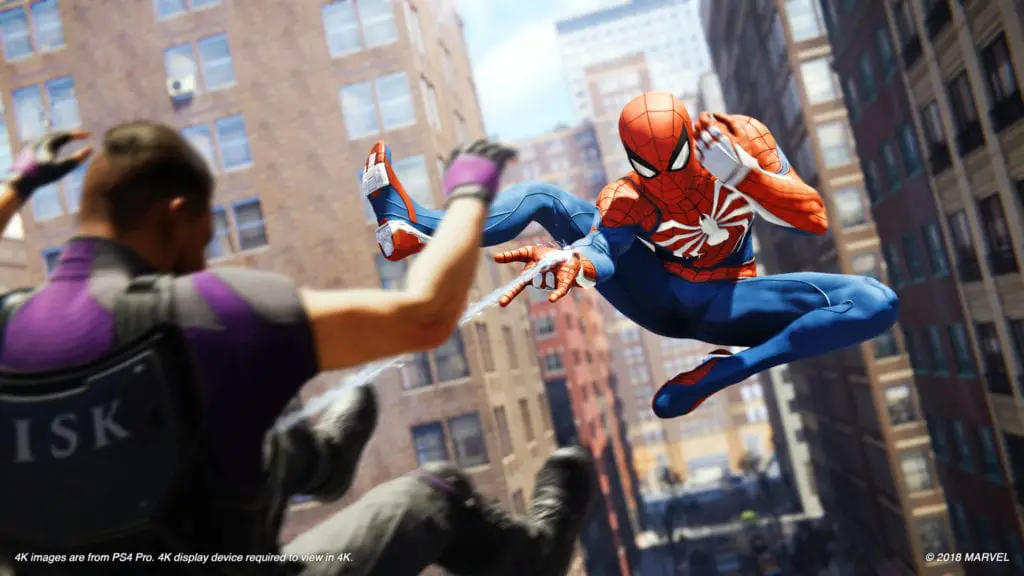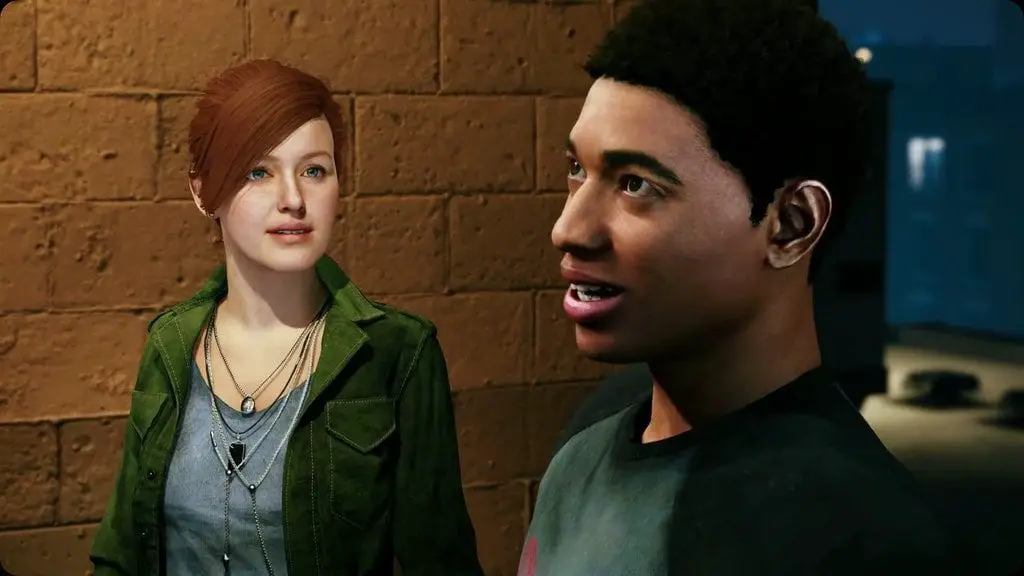Over the long decades of Spider-Man games that have come and gone, the quality has varied wildly. Some have been really good games for their time. Some had a great idea carrying poor gameplay. More often they were plain bad. No matter the quality, though, one thing they all struggled with was the fundamental issue of capturing the feeling of Spider-Man.
The first Spider-Man on the Playstation was an excellent game. It was also limited in how much it could put Spidey’s real power in the hands of gamers. Maximum Carnage has many nostalgic fans, but it was just a side-scrolling beat-em up. The Spider-Man 2 movie game had terrific web-swinging, but was average or bad at everything else. Often the problems were technological. Other times they were an issue with developer skill or budget. Whatever the case no game really made you feel like the guy you read in comics.
And even more than the actual mechanics of being Spider-Man, games struggled to craft stories of the type that made Peter Parker and his crime-fighting alter-ego so iconic. Ultimately it is the relationships between Peter and his friends and foes that make him so popular. You feel an earnest connection to the conflicts driving his stories. Again, some of the failure here for his gaming adventures involves technology. Spider-Man gaming fell off significantly early in the Playstation 2 lifecycle, and gaming storytelling made significant leaps in that time. More often, though, those games just didn’t try particularly hard.
So how fares Insomniac’s attempt to finally give games a true Spider-Man game? How did they approach these problems? Were they ultimately successful? As an Insomniac Games fan since Spyro the Dragon some 20 years ago, I’m happy to say they made the best attempt yet.

Does Whatever a Spider Can
I’ll start with a pretty definitive statement here; no game has ever, ever had Spidey gameplay coming close to what Insomniac managed with this game. Not only that (and I admit this is purely opinion), Spider-Man has taken the Batman: Arkham formula and completely outdone it.
I won’t pretend the game doesn’t blatantly take the Batman formula. The combat certainly does. It’s the same directional, combo-focused, dodge-and-counter style I enjoyed across four Batman games. Thing is, it also addresses many of the problems in those games. Spider-Man’s enemies do not patiently wait as he beats down their friends. They jump in to stop you. They don’t point their guns forever like they forgot how to fire them. Those suckers get unloaded constantly. Spidey doesn’t gravitate from enemy to enemy like his fists have Bat-magnets pulled towards baddie faces. If you’re caught out of position, you’ll flail stupidly and someone will probably smack you for it.
While certainly inspired by Arkham, Spider-Man has a much more aggressive feel that perfectly suits the more agile, frantic, and plain capable nature of its superhero. Spider-Man isn’t a normal human being with crazy ninja training like Batman. He’s a true superhuman. You dodge bullets and rockets flying all over the place. You web people up, throw stuff at them, or even throw them if they’re properly restrained. Spidey flies around combat zones taking advantage of huge amounts of gadgets and suit abilities. His enemies have armor, sniper rifles, rocket launchers, whips, swords, shock gloves, and sometimes even support vehicles.
It makes for a very fast game with more challenge than I expected. The random baddies you find on patrol are perfectly capable of stomping Spidey into the ground. While nothing close to unforgiving, the game does demand the player get a handle on the combat and understand it. Even when you have your trusty standby style and gadgets, optional challenges encourage you to try the many options in ground and aerial combat. You’ll need to in order to acquire the combat tokens used to upgrade the suits and gadgets you like.
Thankfully, this challenge has nothing to do with poor controls. Spider-Man plays like a dream. The controls are smooth, responsive, intuitive, and quickly become second-nature. This allows the player to effortlessly transition between all the tactics needed for late-game encounters. It’s no problem at all to unleash a combo, dodge someone, counter, duck through a shielded opponent’s legs, web up to an aerial enemy, and unleash a special suit move restraining them all with your web.
In fact, the random baddies can be so surprisingly tough that the boss fights feel almost disappointing. Don’t get me wrong; they play well and usually have properly sizable scope. After hours of beating on upwards of like 50 thugs at a time, though, focusing on only one or two supervillains feels almost tame. Especially when few of them try anything particularly innovative in the combat system.
(The highlights are definitely the 2 fights involving Spidey going solo against 2 supervillains. One keeps the Spidey in the air at all times, while the other involves extensive use of the environment.)
But what about the method of traveling between all these fights? How exactly did Spider-Man manage the always important web-swinging mechanic? We all remember Spider-Man 2 and want something matching it, I know. And I won’t say the physics behind Insomniac’s Spider-Man matches its PS2 predecessor.
You know what? I don’t care. Rather than go for something “realistic,” Insomniac went for fun. Give me this any day.
The most important part of the web-swinging, in my humble opinion, is to make you feel like Spider-Man as he zips around New York City. This game manages that and then some. Besides the obvious swinging from building to building, Spidey can zip to ledges and points, vault off them, dive-bomb to pick up speed, and shoot quick webs to propel him forward and maintain speed around corners. He can run up and along buildings with ease. Transitioning from one move to another really lets players keep the speed up with ease.
Insomniac definitely went for accessibility over depth. The right-trigger button puts the player in something of an automatic parkour mode, and you can basically hold it down as you go and pull off what looks like complicated web-swinging and city traversal. However, this won’t make the most of the web-swinging. There’s a learning curve before you find the groove making the most of the speed and flow the web-swinging is capable of.
While the physics may not match what Spider-Man 2 did, don’t listen to anyone who says physics play no role. You can’t swing if there’s nothing your webs can attach to. Where your webs do attach determines the speed and momentum of your swing. Combined with the zip-lines and quick webs and wall running skills, you’ll need to make the most of all these mechanics and physics to become a truly gifted web-swinger. Especially if you want to complete the various challenges and missions.
Within the story missions, Insomniac blends these gameplay elements with well-placed quick time event button presses to create impressive spectacles. Spidey swings from helicopters and stops falling cranes and smashes through glass ceilings while beating on villains. The scale of these events makes for highly memorable moments after the various side content available between them.
Spider-Man’s open world certainly tries nothing new. You stop random crimes, pick up collectibles, activate towers that fill in the map, and take photos of various landmarks. Nothing about it breaks the mold formed by dozens of open-world games before. Where Spider-Man tends to avoid monotony, though, comes from the speed of these tasks. In the time it takes to scale to a viewpoint in Assassin’s Creed, Spider-Man lets you stop a crime, collect a backpack, activate a tower, and be on your way to the next objective. None of these typically mundane tasks feel mundane because of how quickly you complete them. None of these tasks feel lazy or boring when it’s so easy to check multiple items off the list in like 3 minutes. Thus, Spider-Man’s web-swinging adds a fresh new dynamic to the familiar open-world formula.
Like with the combat, it is this speed that defines the game. If you have an aversion to this kind of open-world repetitiveness, I can’t promise this game will overcome it. If one can, though, this may be it. Besides the brisk nature of these tasks, the game also does a good job pacing them. Right when you might be sick of picking up collectibles, enemy strongholds are revealed. You get sick of that and the challenge missions show up. You get sick of random thugs and the research stations unlock.
Overall, Spider-Man takes advantage of its namesake’s abilities, along with some excellent design, to avoid a lot of the flaws in open-world gaming design. It’s a fresh, updated fusion of Batman and Assassin’s Creed. Almost everything about it plays fantastically. If you have any interest in Spider-Man or open-world games, I can’t imagine feeling dissatisfied. Even if you don’t, I think you’d enjoy this game.

Now It’s Personal
But what about the underlying story and characters driving all this gameplay? After all, who cares about gameplay if I feel no motivation around anything? If you’re a Spider-Man fan, I think you’ll be more than satisfied. Insomniac has a GREAT grasp on what makes Spidey and Peter Parker so appealing.
The game takes place 8 years after Peter acquired his powers, bypassing a lot of the “learning to use your powers” stuff we’ve seen and played a thousand times. This allowed Insomniac to build a rich history of what Spider-Man has already done, what kind of relationships he has with those in his life, and how exactly he lives his life. Insomniac uses this basis to build a story and world operating as a love letter to Spidey comics new and old.
From the beginning, we see a familiar picture: Peter Parker struggling between his personal life and his superhero responsibilities. He has a tense post-relationship dynamic with Mary Jane Watson. He helps Aunt May at a homeless shelter. His professional life takes place in a lab with Otto Octavius, who feuds with Mayor Norman Osborn. Peter isn’t the unsure kid facing these difficulties for the first time. That doesn’t mean he fails to struggle. Early in the game, he even loses his apartment after failing to pay rent on time. Said apartment is cluttered with late notices and makeshift gadgets.
To be honest, I think this is the best version of Peter Parker anyone has ever managed, even in comics. He’s a perfect blend of the struggling, responsible dork and super-capable superhero veteran. He blends effortlessly between cracking jokes and dramatic moments. One moment he’s stopping masked thugs, the next he’s freaking out over a text message MJ took the wrong way. Spider-Man never shies from leaning into these moments and letting the emotion and drama of a moment speak for itself.
Peter’s personal relationships lay at the center of the story. Both of the major villains are mentor figures to Peter. Aunt May and Mary Jane feature prominently, including in gameplay. Miles Morales is introduced during one of the game’s big twists and becomes a prominent character afterwards. A pre-Wraith Yuri Watanabe plays a Commissioner Gordon role, and the banter between her and Pete make for some of the game’s funniest moments. Even the lesser supervillains have a history with Spidey that come into play when he confronts them.
Everything is so steeped in personal history and Insomniac does a terrific job relaying that history.
One considerably controversial piece of storytelling occurs through the occasional stealth sections putting Mary Jane Watson and eventually Miles Morales in the player’s hands. Some dislike these sections for interrupting the Spider-Man gameplay with comparably weak content. I actually like them. They’re easy, forgiving, and typically do a great job giving MJ and Miles a key role in the story. They also serve as a perfect example of something I mentioned earlier: the excellent pacing keeping the open-world Spidey gameplay from becoming monotonous.
These gameplay segments are also used to great effect in some key story moments, making you really feel the tension or tragedy of the moment. Plus they do great things for player investment in those characters. Investigative journalist MJ is easily my favorite MJ ever.
The same can be said of the lab puzzles you perform for Octavius. All of the puzzles are pretty easy, quick, and give useful rewards. They help immerse the player in the shoes of Peter Parker, not just Spider-Man. Not everyone likes them, and I get it. Insomniac does, too. They let the player skip them completely while also receiving the rewards for them. It’s the storytelling purpose of these segments that matter and are why they exist.
Overall the story doesn’t hit any particularly groundbreaking beats. Does it matter when they hit the familiar beats so well? Seeing the degradation of some relationships alongside the rehabilitation of others makes for some fantastically well-told moments. Insomniac succeeds with storytelling no Spider-Man game would attempt 10-20 years ago. Some of the more dramatic plot points rank among some of my favorite video game moments in recent years.
And when it all finally comes to an end, the game pulls no punches. The final boss has all the emotion you’d expect after hours of build-up, and afterwards, Peter is forced to make one last decision perfectly representing the idea of “with great power, comes great responsibility.” In fact, the ending can be seen as a direct rebuke of an infamous Spider-Man story from the 2000s.
Overall, like with the gameplay, no Spider-Man game has ever captured his life this well. Insomniac chose to create a Spidey game for a reason, and I think their love for the character shines in every second of this experience. I wish I could delve into a more spoiler-y summary of it to make this opinion more clear.
Perhaps myself or someone else will eventually, because I think Spider-Man deserves it.

Final Thoughts
I won’t say this is the best game of the year. Not with Assassin’s Creed: Odyssey currently receiving hype as the best game the series has put out in years, and definitely not with Red Dead Redemption II releasing this month. You also have to consider God of War, Monster Hunter, Dragon Ball Fighterz, etc….it’s a hard slog to proclaim Spider-Man the best of that bunch.
As a Spidey fan, though, I can’t imagine anything besides Red Dead possibly competing for the title of my favorite game this year. This is the best Spidey game yet.
There’s certainly room to improve. The game kind of bogs down in the final act, with an excessive amount of armed thugs lying around. The open world stuff could be more imaginative. Improvements can be made to the web-swinging. I’d also love to see inspired boss fights taking full advantage of the combat’s depth. Also, no symbiote suit? Really?
Considering the obvious sequel setup this game ends on, I’m sure we will get these improvements and then some. Insomniac knows how to do sequels. Just look at the sequels to Spyro the Dragon or Ratchet and Clank.
For now, though, I prefer to bask in the many, many things Spider-Man does right. I was skeptical this game would be anything more than solid, and feared the worst. Years of Spidey-related disappointments trained to temper my expectations. Instead I got something very, very good, but just short of great. But it was great enough for this Spidey fan.
You can bet that for once, I’ll be ready to pre-order a sequel immediately.

